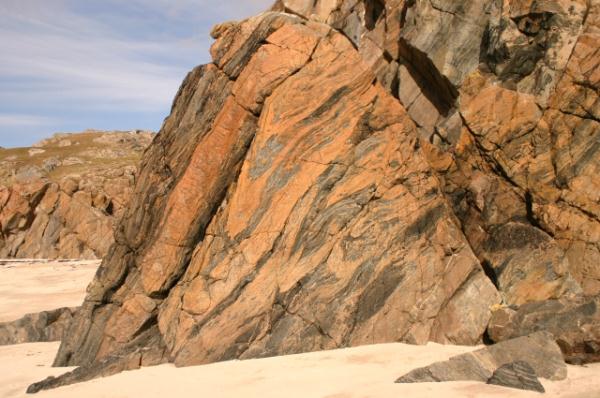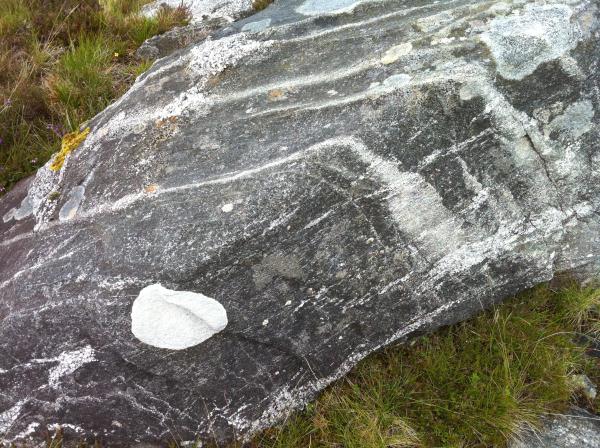The rocks that form the incredible landscape here, like a moonscape, are some of the oldest in Europe and indeed the World.
Dating back between 3.1 and 2.8 billion years (almost 2/3rds of the age of the Earth itself) to the little understood Precambrian era, Lewisian Gneiss is the predominant bedrock throughout the Outer Hebrides.
The Earth´s crust is from time to time subjected to stresses generated within the crust, which cause it to break to form faults, and also to bend forming folds.
This process often occurs along narrow regions which results in mountain chains. Rocks within a mountain chain not only sustain considerable pressures but are also heated both generally and by the large scale of intrusion of magma, with the effect that rocks are deformed and recrystallized to varying degrees. Such rocks are called metamorphic rocks.
Gneiss is an example of metamorphic rock in which a sedimentary or igneous rock has been deeply buried and been subjected to very high temperatures and pressures. The streaks characteristic of Gneiss are composed of minerals, which have penetrated and recrystallized within the rock. The result of the metamorphism is that all previous traces of the original structure of the sedimentary or igneous rock, like fossils and layering, are obliterated.
Gneiss makes up the largest part of the Earth's lower crust. Pretty much everywhere on the continents, you could drill straight down and eventually strike gneiss.
Gneiss is an old German word meaning bright or sparkling.
Despite its highly altered nature, gneiss can preserve geochemical evidence of its history, especially in minerals like zircon, which resist metamorphism.
The oldest crustal rocks known are gneisses from western Greenland. Their carbon isotopes show that life existed there at that time, nearly four billion years ago.

Figure: Geological map of the Hebridean Terrane showing distribution of rocks of the Lewisian complex
On your travels round the island, you might see the gneiss's delicate pink colours exposed to view, and some geologists refer it to this as "The Old Boy”.

Outcrop of weathered Lewisan Gneiss with pink colouring.
The rocks are very resistant to weathering, as is granite generally, and make for poor cultivating areas. For a period of about 1.5 billion years after they were formed, these gneisses were subjected to many geological processes, including the stretching of the crust as a result of volcanic activity and collision of the ancient continents, which led to mountain building.
About 1.6 billion years ago, they became part of a stable continent and were largely unaffected by the surrounding geological events until almost the present day (in geological terms).
Finally, within the last 2.6 million years, during the last ice age, the gneisses that were at the surface were eroded and polished by glaciers and oceans to create the landscape you see today.
In particular, lochan depressions filled with fresh water, are a local feature of that erosion and landscaping.
To claim this cache, please read the local information board and please send me an email (click on the name ivymill in the heading above, or via my profile page) with the answer to the two questions below. I will then email you a response (normally within 48 hours) to say whether you can log your find or not. When you do log, please post a photograph on the site of you and/or your GPS at the location, or of any other interesting Gneiss on the Isle of Harris. Good luck and enjoy the experience!
1. What type of rock did blasting expose when the road near to Roghadal pier was being built?
2. Name one of the three types of igneous rock (orthogneiss) that makes up the nearby landmark hill of Roineabhal (Roneval).
3. Finally – once you have had an email response from me saying you can log your find, please post a photo of yourself and/or your GPS taken at the cache site with your log.

Sources:
The Geodiversity of the Isle of Harris (British Geological Survey Report (CR/07/032N)– K M Goodenough and A Finlayson 2006. Copyright NERC 2006
Wikipedia:
http://en.wikipedia.org/wiki/Hebridean_Terrane http://en.wikipedia.org/wiki/Lewisian_complex http://en.wikipedia.org/wiki/Gneiss
Information board at cache location